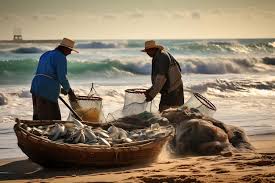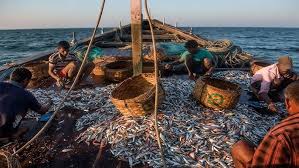“Fish” is a term used to describe all living produce of water, including fin-fish and poikilothermic vertebrates that breathe using gills and move using fins. This category of water production is regarded as “fish” because it dominates 90% of aquatic food resources.
However, other aquatic living produce of water that is economically important to man are reptiles (crocodiles, sea turtles); mammals (whales, tortoises, dolphins, seals); other aquatic invertebrates (crustaceans: shrimps, crabs, lobsters); mollusks (oyster clams, periwinkles, cuttlefish); and aquatic plants such as seaweeds and coral reefs.
1. Food for Human Consumption
Fish, particularly fin-fish, is regarded as first-class protein (provides 16% of the world population’s protein), containing an abundant calorific value, vitamins, phosphorus, and other essential elements for good growth and maintenance of a healthy body.
Other food fish products are shelled mollusks (clam, mussel, oyster, winkle, and scallop) and crustaceans (shrimp, lobster, crayfish, crab), eggs (roe) of various species of fish, marine invertebrates (sea urchins, shrimp), squid, octopus, sea cucumber and certain jellyfish species.
Marine plants also serve as food (seaweeds) as well as a suspending, thickening, stabilizing, and emulsifying agent in dairy products (Irish Moss).
In 2002, about 76% of the estimated world fisheries were used for direct human consumption. Fish products include canned products, fresh and frozen products, pickled, spiced, and marinated products, salted and/or dried products, and prepared/secondary products.]
Read Also: Spatial Distribution of Soil Types
2. Non-Food Fish Products such as Fish Meal and Fish Oil are used as Dietary Supplements in Livestock Production
In 2002, their manufacture accounts for 24% of world fisheries production.
Some parts of the fish body are used for purposes such as leather and polishing materials (skin of some cartilaginous fishes e.g. carp), scales coating glass beats, and artificial pearls. Non-food fish products, such as fish oil, are used in the manufacture of soap and other pharmaceutical products.
Sea horses, starfish, sea urchins and sea cucumber are used for traditional medicine in China. Eating fish and seafood has been reported to reduce the risk of chronic illness in Canada.
Pigments such as Tyrian purple are made from marine snails and sepia from the inky secretions of cuttlefish. Phycocolloids (extracted from seaweed) and certain fine biochemicals have valuable industrial uses.
Fish glue, made by boiling the skin, bones, and swim bladders of fish, is valued for use in several products including illuminated manuscripts and Mongolian war bow.
Isinglass, a substance obtained from the swim bladders of fish (especially sturgeon) is used for the clarification of wine and beer.
Fish emulsion is a fertilizer emulsion produced from the fluid remains of fish processed for fish oil and fish meal industrially. Knotted wrack is used for making liquid fertilizer.

Shark skin and ray skin which are covered with tiny teeth (dermal denticles) are used as sandpaper.
The above-mentioned skins are used for leather; shark skin leather is used in the manufacture of hilts of traditional Japanese swords. The skin of hagfish is used for making “eel leather” converted into “eelskin” products in Korea.
Whole fish e.g. cleupids, enchovy, capeline, and other discards (wastes), and shrimp heads are used for producing animal feeds (fish meal, silage).
Fish waste product (offal; consists of skins, heads, eviscera/internal organs, bone/cartilage) is used for organic farming, fish meal production (48-52% protein), liquefied fish (by addition of enzymes), composting (high in nitrogen), commercial baits (buffalo fish heads, carp heads, whole carp, sucker heads, shad), production of formulated bait (crab, crayfish, lobster) and formulated feed (aquaculture).
Provision of income and employment – Fisheries and aquaculture provide full-time, part-time, and occasional primary sector employment; aquaculture provides increasingly more opportunities than capture fisheries. Worldwide in 2002, this workforce represented 2.8% of the 1.33 billion people economically active in agriculture.
Fish is desired for recreational fishing through angling (shortfin mako, longfin mako, white shark, bluefin tuna), fishkeeping, and sport fishing of both freshwater fish (bass, trout, salmon, catfish, yellow perch) and saltwater fish (swordfish, tuna, marlin, halibut, salmon).
Fish is caught indirectly for human consumption in industrial fisheries.
Fish serves as ornamentals and for common exhibitions e.g. freshwater fishkeeping, marine aquaria, brackish water aquaria, home aquaria, offers, etc. Pearl and mother-of-pearl are valued for their luster. Spa treatments are very rich in minerals and enzymes.
Some seafood restaurants keep live fish for cultural beliefs, as deities and religious symbols.
Fish trade; live fish, pearl trade, trade of dry cod, etc.
Bacteriological agar from cultivated Geldium, a type of red algae, is used for cutting bacteria and other microorganisms in most laboratories in British Columbia.
Hagfish are currently of special interest in genetic analysis of the relationships between chordates; the mucus secreted by the fish includes strong, thread-like fibres similar to spider silk which has potential uses as new biodegradable polymers, space-filling gels, and as a means of stopping blood flow in accident victims and surgery patients.
Read Also: The Recommended Systems of Livestock Management
Read Also: How Family Farming Can Yield Global Food Sufficiency

